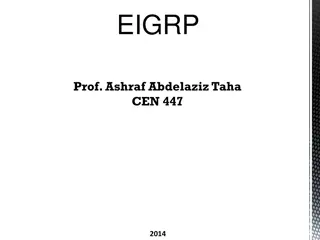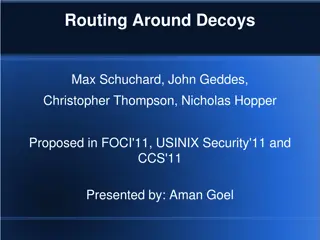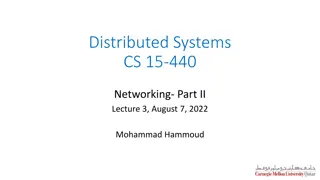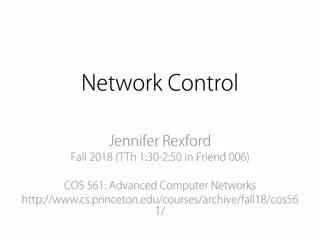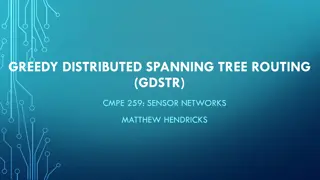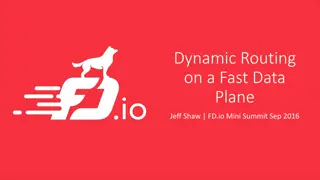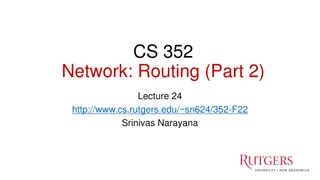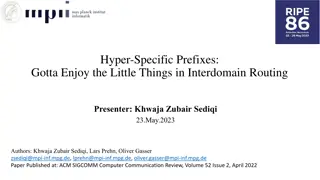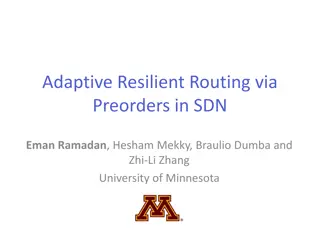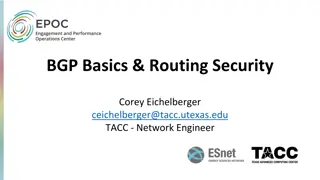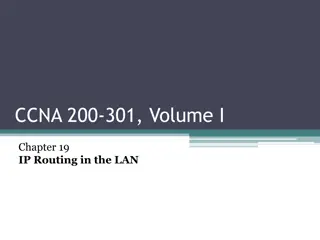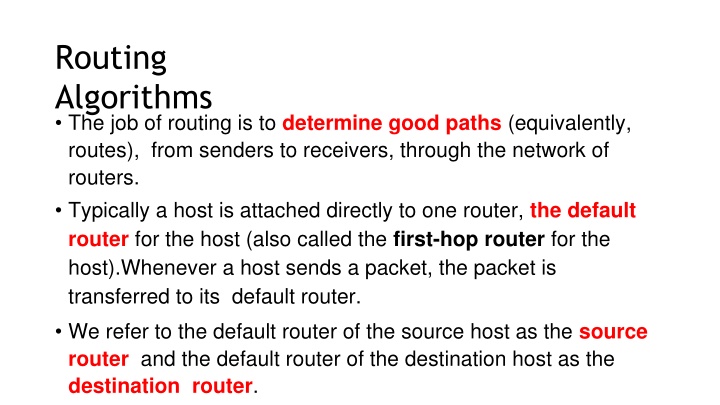
Understanding Routing Algorithms in Computer Networks
Learn about the purpose of routing algorithms in computer networks, how paths are determined, and the importance of finding the least costly routes. Explore different types of routing algorithms and their classifications in this comprehensive guide.
Download Presentation

Please find below an Image/Link to download the presentation.
The content on the website is provided AS IS for your information and personal use only. It may not be sold, licensed, or shared on other websites without obtaining consent from the author. If you encounter any issues during the download, it is possible that the publisher has removed the file from their server.
You are allowed to download the files provided on this website for personal or commercial use, subject to the condition that they are used lawfully. All files are the property of their respective owners.
The content on the website is provided AS IS for your information and personal use only. It may not be sold, licensed, or shared on other websites without obtaining consent from the author.
E N D
Presentation Transcript
Routing Algorithms The job of routing is to determine good paths (equivalently, routes), from senders to receivers, through the network of routers. Typically a host is attached directly to one router, the default router for the host (also called the first-hop router for the host).Whenever a host sends a packet, the packet is transferred to its default router. We refer to the default router of the source host as the source router and the default router of the destination host as the destination router.
The purpose of a routing algorithm is then simple: given a set of routers, with links connecting the routers, a routing algorithm finds a good path from source router to destination router. Typically, a good path is one that has the least cost. A graph is used to formulate routing problems. Recall that a graph G = (N,E) is a set N of nodes and a collection E of edges, where each edge is a pair of nodes from N. In the context of network-layer routing, the nodes in the graph represent routers the points at which packet-forwarding decisions are made and the edges connecting these nodes represent the physical links between these routers. Such a graph is an abstraction of a computer network.
An edge also has a value representing its cost. Typically, an edge s cost may reflect the physical length of the corresponding link, the link speed, or the monetary cost associated with a link. For any edge (x,y) in E, we denote c(x,y) as the cost of the edge between nodes x and y. If the pair (x,y) does not belong to E, we set c(x,y) = . Consider only undirected graphs (i.e., graphs whose edges do not have a direction), so that edge (x,y) is the same as edge (y,x) and that c(x,y) = c(y,x).
A natural goal of a routing algorithm is to identify the least costly paths between sources and destinations. To make this problem more precise, recall that a path in a graph G = (N,E) is a sequence of nodes (x1, x2,..., xp) such that each of the pairs (x1,x2),(x2,x3),...,(xp-1,xp) are edges in E. The cost of a path (x1,x2,..., xp) is simply the sum of all the edge costs along the path, that is, c(x1,x2) + c(x2,x3) + ...+ c(xp-1,xp). Given any two nodes x and y, there are typically many paths between the two nodes, with each path having a cost. One or more of these paths is a least-cost path. The least-cost problem is therefore clear: Find a path between the source and destination that has least cost. For example, the least-cost path between source node u and destination node w is (u, x, y, w) with a path cost of 3. Note that if all edges in the graph have the same cost, the least- cost path is also the shortest path.
Classification of Routing Algorithms global routing algorithm / decentralized routing algorithm static routing algorithms / Dynamic routing algorithms load-sensitive algorithm / load-insensitive algorithm
global routing algorithm A global routing algorithm computes the least-cost path between a source and destination using complete, global knowledge about the network. That is, the algorithm takes the connectivity between all nodes and all link costs as inputs. This then requires that the algorithm somehow obtain this information before actually performing the calculation. In practice, algorithms with global state information are often referred to as link-state (LS) algorithms, since the algorithm must be aware of the cost of each link in the network.
decentralized routing algorithm In a decentralized routing algorithm, the calculation of the least-cost path is carried out in an iterative, distributed manner. No node has complete information about the costs of all network links. Instead, each node begins with only the knowledge of the costs of its own directly attached links. The decentralized routing algorithm is called a distance-vector (DV) algorithm, because each node maintains a vector of estimates of the costs (distances) to all other nodes in the network.
In static routing algorithms, routes change very slowly over time, often as a result of human intervention (for example, a human manually editing a router s forwarding table). Dynamic routing algorithms change the routing paths as the network traffic loads or topology change.
In a load-sensitive algorithm, link costs vary dynamically to reflect the current level of congestion in the underlying link. If a high cost is associated with a link that is currently congested, a routing algorithm will tend to choose routes around such a congested link. Today s Internet routing algorithms (such as RIP, OSPF, and BGP) are load-insensitive, as a link s cost does not explicitly reflect its current congestion. (or recent past) level of
The Distance-Vector (DV) Routing Algorithm The distancevector asynchronous, and distributed. It is distributed in that each node receives some information from one or more of its directly attached neighbors, performs a calculation, and then distributes the results of its calculation back to its neighbors. It is iterative in that this process continues on until no more information is exchanged between neighbors. The algorithm is asynchronous in that it does not require all of the nodes to operate. (DV) algorithm is iterative,
In the DV algorithm, a node x updates its distance-vector estimate when it either sees a cost change in one of its directly attached links or receives a distancevector update from some neighbor. the only information a node will have is the costs of the links to its directly attached neighbors and information it receives from these neighbors. Each node waits for an update from any neighbor calculates its new distance vector when receiving an update and distributes its new distance vector to its neighbors . DV-like algorithms are used in many routing protocols in practice, including the Internet s RIP and BGP, ISO IDRP, Novell IPX, and the original ARPAnet.
Convergence: Process of getting consistent routing information to all the nodes. Node gives routing update under 2 circumstances: 1. Periodic Update 2. Triggered Update due to link failure or when a node receives update from one of its neighbors. How to detect node failure? 1. Send a control packet and wait for acknowledgement 2. If periodic update is not received for the last few update cycles. Drawback Count to infinity problem Solution Split Horizon Split Horizon with poison reverse
The Link-State (LS) Routing Algorithm In a link-state algorithm, the network topology and all link costs are known, that is, available as input to the LS algorithm. Objective-to find the least cost path from source router to destination router In practice this is accomplished by having each node broadcast link- state packets to all other nodes in the network, with each link-state packet containing the identities and costs of its attached links. All nodes have an identical and complete view of the network.
Link state routing protocol rely on two mechanisms: Reliable dissemination of link state information i.e Flooding Calculation of route from the sum of all accumulated link sate knowledge
Link-State Database (LSDB) Each node needs to have a complete map of the network, this collection of states for all links is called the link-state database (LSDB).
Flooding. Each node can send some greeting messages to all its immediate neighbors (those nodes to which it is connected directly) to collect two pieces of information for each neighboring node: The identity of the node The cost of the link. The combination of these two pieces of information is called the LS packet (LSP); This LSP is sent out of each interface. When a node receives an LSP from one of its interfaces, it compares the LSP with the copy it may already have. If the newly arrived LSP is older than the one it has (found by checking the sequence number), it discards the LSP. If it is newer or the first one received, the node discards the oldLSP (if there is one) and keeps the received one..



